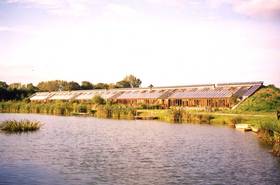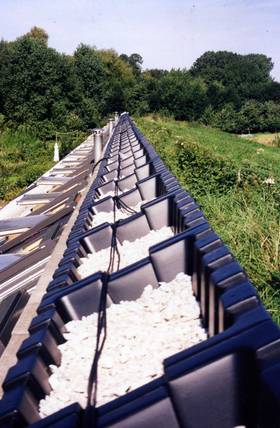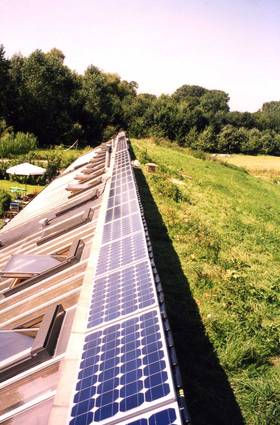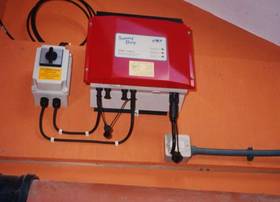UK DTI’s Solar Photovoltaic Domestic Field Trial
UK Department of Trade & Industry (DTI)’s solar photovoltaic domestic field trial
The DTI Sustainable Energy Programme – PV Domestic Field Trial began in 2000 and consisted of both domestic and large-scale projects (total budget of £9.4 million, total installed capacity of about 1.5 MWp)and provided grants were intended to provide opportunities to monitor system performance, build industry experience and refine installation and design practices. It comprised the installation of more than 470 PV systems (totalling over 750 kWp) in a wide range of domestic building across the UK.
Hockerton Housing Project



The Hockerton Housing Project (HHP) in Nottinghamshire is the UK's first earth sheltered, self-sufficient ecological housing development. Project members live a holistic way of life in harmony with the environment, in which all ecological impacts have been considered and accounted for.
The residents of the five houses generate their own clean energy, harvest their own water and recycle waste materials causing no pollution or carbon dioxide emissions. The houses are amongst the most energy efficient, purpose built dwellings In Europe. They were designed by Brenda & Robert Vale (See The Autonomous House) but were originally built without any renewables.
HHP erected a 6kW Proven wind turbine on a 28m tower in early 2002. This was one of the first examples in the UK of a community owned wind turbine, whereby the owners are supplied directly with the ‘clean’ renewable energy produced.
Wind & Sun had been involved with HHP through their connections with the Vales since it’s inception and so when the PV Domestic Field Trial was announced we contacted them to help put together a proposal that would help with funding PV's (photovoltaics - generation of electricity from solar power) to compliment the wind power.
Some match-funding was also obtained from Powergen.
Read more about Hockerton Housing Project






The PV System




The PV system consists of six identical 1.275 kWp PV arrays, each consisting of 15 x BP Solar BP585 modules connected to SMA Sunny Boy SWR 1100E inverters. The peak output is 7.65 kW, or 85W peak from each of the 90 panels.
The system was installed in August 2002.
Orientation of the buildings and the arrays is SSW.
The majority of modules (76) are mounted along the conservatory parapet using 'ConSole' flat roof mounts with an inclination of 25 deg. These are black plastic tubs filled with stone ballast which don't require mechanical fixing or roof penetrations. They can also be moved relatively easily, given sufficient cable length, for roof maintenance purposes. In addition 7 modules are mounted on each end of the development on a galvanized steel framework fastened to concrete paving slabs with an inclination of 30 deg.
BRE in their Second Annual Technical Report for the DTI commented "In terms of architectural integration, this installation surpasses many others since the PV seems to complement the sunspace to the extent the building would look deficient without it. The angle of the PV modules is similar to that of the sunspace; this presumably having also been designed to increase the energy harnessed."
The most obvious lesson learned is that the system has proved to be very reliable with very little maintenance necessary. Visually the PV’s have been accepted by the residents and are considered to add to the houses appearance from the front of the properties. The electricity produced has been above the predicted system yield which gives a feel good factor to the residents.
The work was carried out by ‘Wind & Sun’ with ‘Hockerton Housing Project Trading Ltd’. Monitoring equipment was installed by ‘SunDog Ltd’.








Updates



At the beginning of 2005, after 18 months of construction and kitting out, HHP opened its ‘Sustainable Resource Centre’ (SRC) for visitors The building was designed, work supervised and most of the labour contributed by project members themselves.
The new offices and visitors centre were designed to meet the same high standards as the homes. To meet the ‘Zero CO2’ requirements of the new community building, HHP purchased a second wind turbine. The 5kW rated turbine was supplied by Iskra (now Britwind) and is of a similar size to the Proven machine.
Additional PV panels were added to the roof of this building in 2012 as energy use increased due to the level of work on-site, and to prepare for electric cars.
The first wind turbine was subject to considerable local opposition, but 8 years later HHP, working on behalf of local group Sustainable Hockerton, project managed the financing and installation of a community owned second-hand 225kW Vestas V29 wind turbine which offsets the electricity use of the 54 households in Hockerton parish.





